brake fluid AUDI R8 SPYDER 2014 Owners Manual
[x] Cancel search | Manufacturer: AUDI, Model Year: 2014, Model line: R8 SPYDER, Model: AUDI R8 SPYDER 2014Pages: 244, PDF Size: 61.06 MB
Page 5 of 244
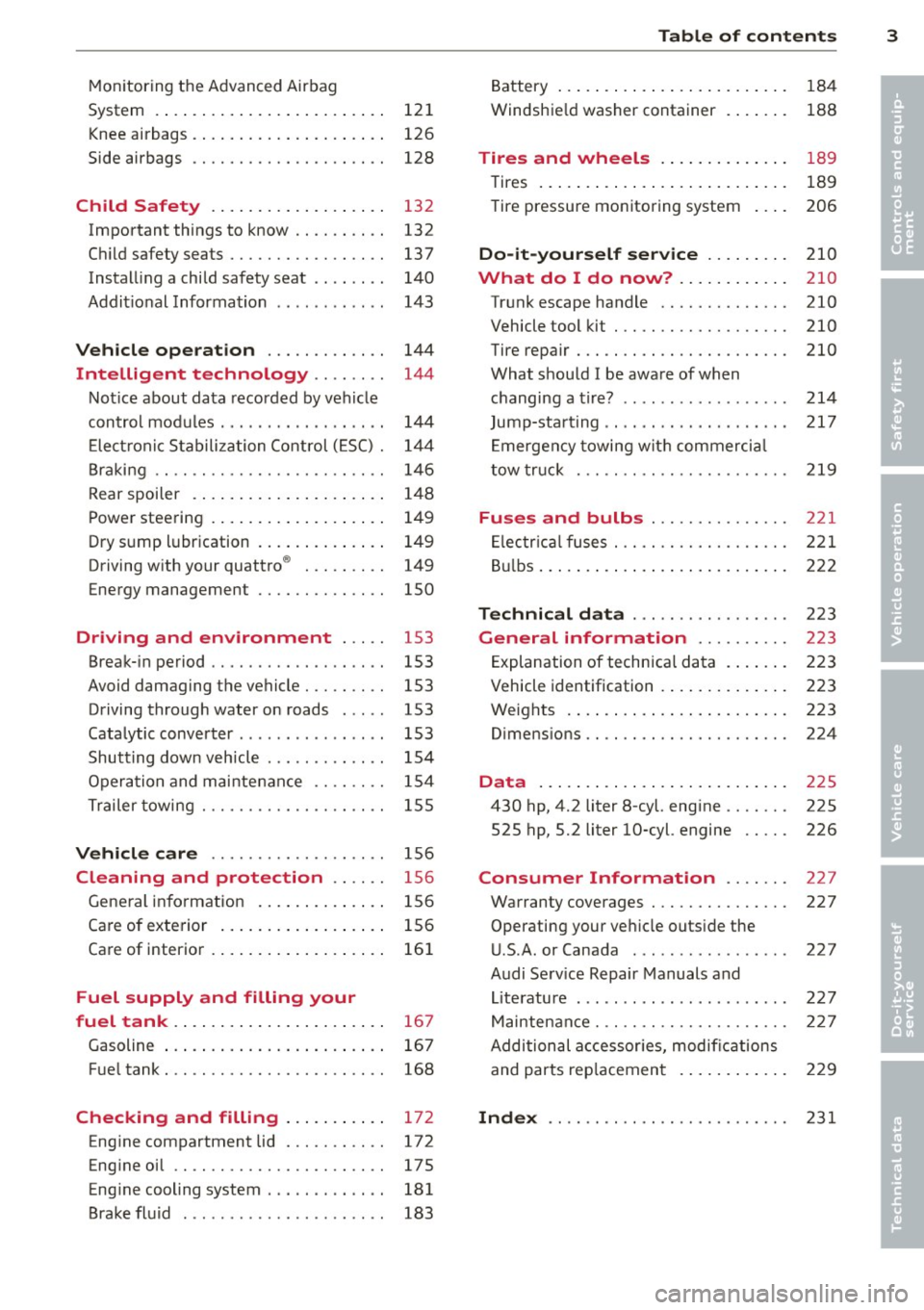
Monitoring the Advanced Airbag
System . . . . . . . . . . . . . . . . . . . . . . . . . 121
Knee airbags . . . . . . . . . . . . . . . . . . . . . 126
Side airbags . . . . . . . . . . . . . . . . . . . . . 128
Child Safety . . . . . . . . . . . . . . . . . . . 132
Important things to know . . . . . . . . . . 132
C hild safety seats . . . . . . . . . . . . . . . . . 137
Installing a child safety seat . . . . . . . . 140
Additional Information . . . . . . . . . . . . 143
Vehicle operation . . . . . . . . . . . . . 144
Intelligent technology . . . . . . . . 144
Notice about data recorded by vehicle
control modules . . . . . . . . . . . . . . . . . . 144
E lect ronic Stabilization Control (ES C) . 144
B raking . . . . . . . . . . . . . . . . . . . . . . . . . 146
Rear spoiler . . . . . . . . . . . . . . . . . . . . . 148
Power steering . . . . . . . . . . . . . . . . . . . 149
Dry sump lub rication . . . . . . . . . . . . . . 149
Driving with your quattro ® . . . . . . . . . 149
Energy management . . . . . . . . . . . . . . 150
Driving and environment . . . . . 153
Break- in period . . . . . . . . . . . . . . . . . . . 153
Avoid damaging the vehicle . . . . . . . . . 153
Driving through water on roads . . . . . 153
Catalytic converter . . . . . . . . . . . . . . . . 153
Shutting down veh icle . . . . . . . . . . . . . 154
Operation and maintenance . . . . . . . . 154
Trailer towing . . . . . . . . . . . . . . . . . . . . 155
Vehicle care . . . . . . . . . . . . . . . . . . . 156
Cleaning and protection . . . . . . 156
General information . . . . . . . . . . . . . . 156
Care of exterior . . . . . . . . . . . . . . . . . . 156
Care of interior . . . . . . . . . . . . . . . . . . . 161
Fuel supply and filling your
fuel tank . . . . . . . . . . . . . . . . . . . . . . .
167
Gasoline . . . . . . . . . . . . . . . . . . . . . . . . 167
Fuel tank. . . . . . . . . . . . . . . . . . . . . . . . 168
Checking and filling . . . . . . . . . . . 172
Eng ine compartment lid . . . . . . . . . . . 172
Eng ine oil . . . . . . . . . . . . . . . . . . . . . . . 175
Eng ine cooling system . . . . . . . . . . . . . 181
Brake fluid . . . . . . . . . . . . . . . . . . . . . . 183
Table of contents 3
Battery ... .. .... ... .. .......... . 184
Windshield washer container
188
•
•
Tires and wheels ........... .. . 189
Tires ..... .. .... ... .. .......... .
189
Tire pressure monitoring system
206
Do-it-yourself service ........ . 210
What do I do now? ........... . 210
Tr unk escape handle ........... .. .
210
Vehicle tool kit . .. ............... .
210
Tire repair . .. .. .. ............... .
210
What should I be aware of when
h . t· 7 c
anging a rre . . .. .............. . 214
Jump-starting .. .. ... .. .. ... ..... . 217
Em ergency towing with commercial
tow truck ... .. .. .. . ............ . 219
Fuse s and bulbs ... ........... . 221
El ectr ical fuses . .. ............... . 221
Bulbs ..... .. .. .. .. .. ........... . 222
Technical data ..... ........... . 223
General information ......... . 223
Explanation of technical data ...... . 223
Vehicle identification ........... .. .
223
Weights .. .. .. .... .. ........... .
223
Dimens ions .. .. ...... ........... . 224
Data ..... .. .... .. . .. .......... . 225
430 hp, 4.2 liter 8-cyl. engine ...... .
225
525 hp, 5.2 liter 10-cyl. engine .... .
226
Con sumer Information ...... . 227
Warranty coverages .............. . 227
Operating your vehicle outside the
U .S.A . or Canada ... . .. .. ...... .. . 227
Audi Serv ice Repair Manuals and
literature ... .. .. .. . .. .. ..... ... . 227
Maintenance . .. .. ............... . 227
Additional accessories, modifications
and parts replacement . . . . . . . . . . . . 229
Index . . . . . . . . . . . . . . . . . . . . . . . . . . 231
Page 15 of 244
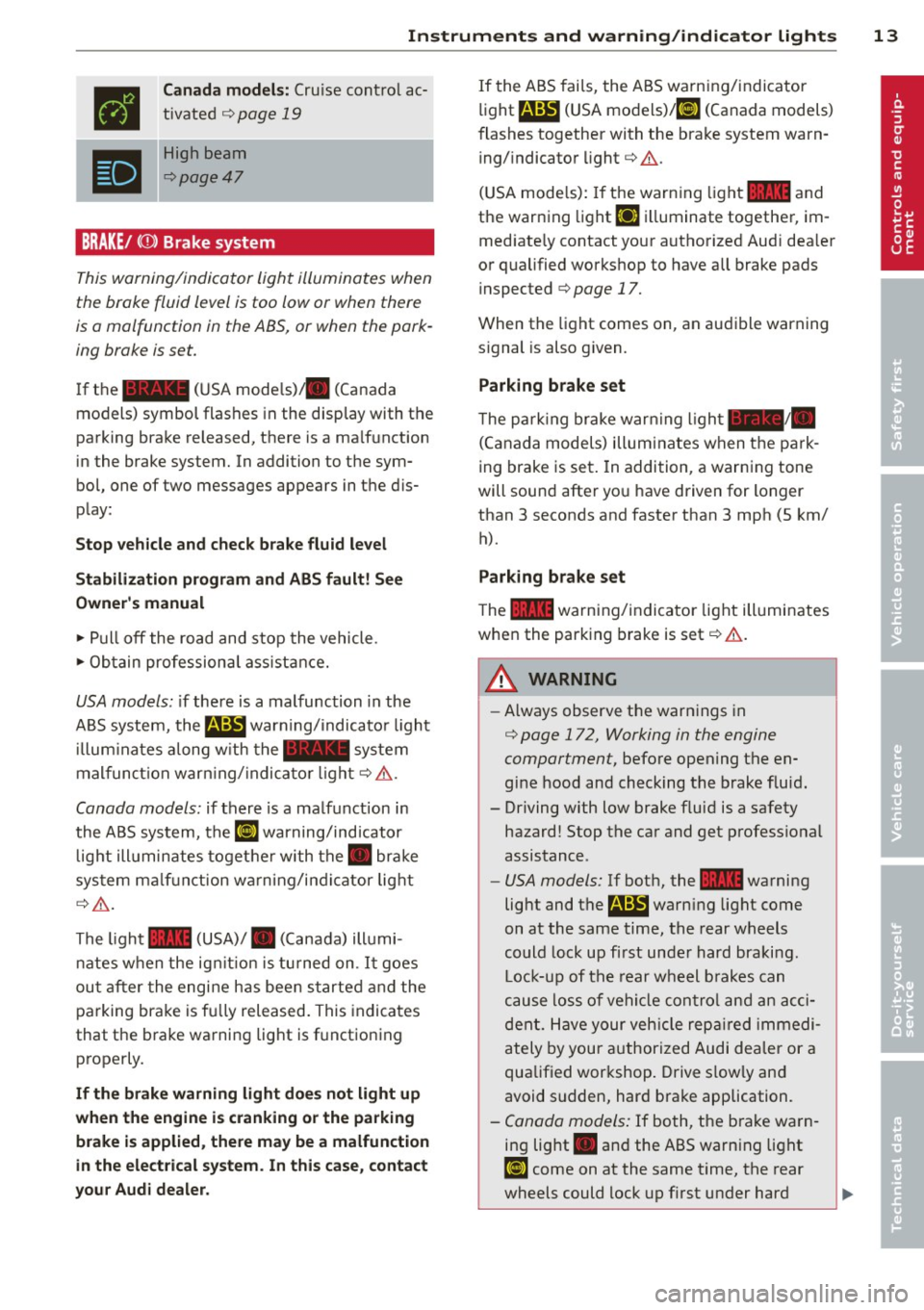
Instrument s and warnin g/indic ator ligh ts 13
•
•
C anada mod els: Cru ise contro l ac
tivated ¢
page 19
High beam
¢page47
BRAKE/ (CD) Brake system
This warning/indicator light illuminates when
the brake fluid level is too low or when there
is o malfunction in the ABS, or when the park
ing brake is set.
I f the - (USA mode ls)/ . (Canada
models) symbol flashes in the display with the
parking brake released, there is a ma lfunction
in the brake system. In addition to the sym
bol, one of two messages appears in the d is
play:
Stop vehicl e and ch ec k brak e fluid le vel
Stabili zati on p ro g ram and AB S fault! Se e
Owne r's manual
"' Pull off the road and stop the vehicle .
"' Ob tain professiona l ass istance.
USA models: if there is a malfunction in the
ABS system, the
B warn ing/indicato r light
i llum inates a long w ith the - system
mal funct ion warning/ indica to r light ¢&. .
Canada models : if there is a malfunction in
the ABS system, the
[iJ warning/indicator
light ill uminates togethe r with the. brake
system ma lf u nction warning/indicator light
¢ &_ .
The light 1111 (USA)/ . (Canada) illumi
n ates when the ig nitio n is tu rned on . It goes
ou t after the engine has bee n started and the
pa rking brake is fu lly released. This indicates
that the brake warning lig ht is functioning
properly.
If the br ake warning li ght do es not light up
w hen the engine i s cranking or the pa rking
bra ke i s a pplied, the re m ay be a malfun ction
in the electric al sy stem. In thi s cas e, cont act
y ou r Au di dealer .
If the ABS fai ls, the ABS warning/indicator
light
B (USA models)/ [iJ (Canada models)
flashes together with the brake system warn
ing/ indicator light ¢&. .
(USA mode ls): If the warning light
1111 and
the warning light
£1 ill uminate together, im
med iate ly contact your authorized Aud i dea ler
or qualified workshop to have all brake pads inspected ¢
page 17.
When the light comes on , an audible warning
s ignal is also g iven.
Parking brake set
T he pa rk ing brake warning ligh t-·
(Canada models) illuminates when the park
ing brake is set . In addition, a warning tone
will sound after yo u have driven for longer
than 3 seconds and faster than 3 mph (5 km/
h).
Parking b ra ke s et
The llll warning/indicator light illuminates
when the parking brake is set¢&. .
_& WARNING
-Always observe the warn ings in
¢ page 172, Working in the engine
compartment,
before opening the en
gine hood and checking the brake f luid.
- Driving with low brake fluid is a safety hazard! Stop the car and get profess ional
assistance .
-USA models: If both, the 1111 warning
light and the
E warn ing light come
on at the same time, the rear wheels
could lock up first unde r hard braking.
Lock-up of the rear wheel b rakes can
cause loss of vehi cle con tro l and an acci
dent. Have your veh icle repa ired immedi
ately by your authorized Audi dealer or a
qualified workshop . Drive s lowly and
avoid sudden, hard brake application.
- Canada models: If both, the b rake warn
ing light . and the ABS warning light
[iJ come on at the same time, the rear
wheels could lock up f irst under hard
~
Page 16 of 244
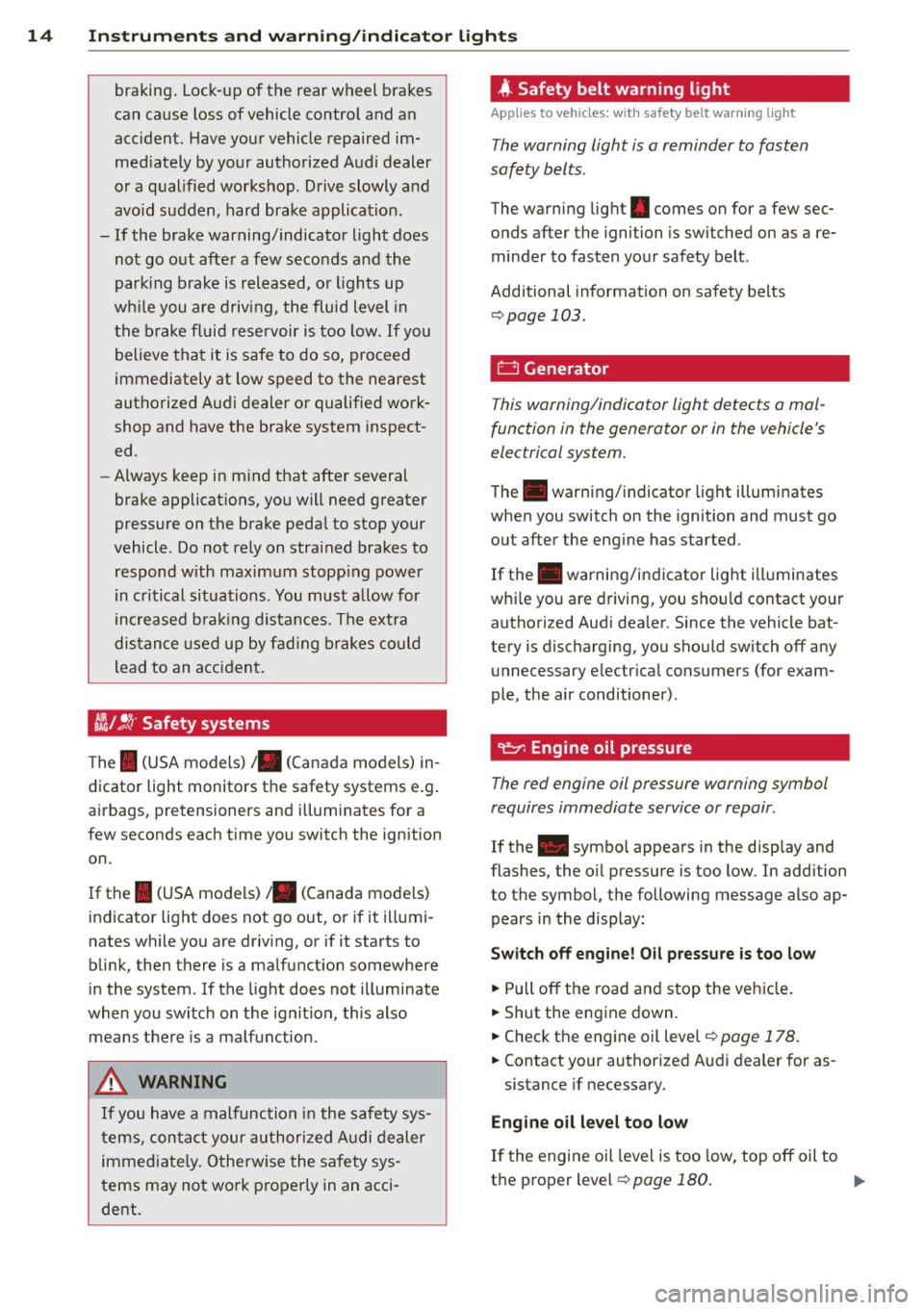
14 Instrum ent s and w arn ing /indic ato r light s
braking. Lock-up of the rear wheel brakes
can cause loss of vehicle control and an
accident. Have your vehicle repaired im
med iately by your authorized Audi dealer
or a qualified workshop. Drive slowly and
avo id sudden, hard brake applicat ion .
- If the brake warning/indicator light does
not go out after a few seconds and the
parking brake is released, or lights up
wh ile you are driving, the fluid level in
the brake fluid rese rvoir is too low. If you
believe that it is safe to do so, proceed
immediately at low speed to the nearest
authorized Audi dealer or qualified work
shop and have the brake system inspect
ed.
- Always keep in m ind that afte r several
brake applicat ions, yo u will need greater
pressure on the brake peda l to stop your
vehicle. Do not re ly on stra ined brakes to
respond w ith maximum stopp ing power
in c ritical situations. You must a llow for
increased bra king distances. The extra
dis tance used up by fad ing br akes could
lead to an acc ident .
~/ !lr Safety systems
The I (USA models)/ . (Canada models) in
dicator light monitors the safety systems e.g .
airbags, pretensioners and i llum inates for a
few seconds each time you switch the ignition
on.
I f t he
I (USA models) • (Canada models)
indicator light does not go out, or if it illumi
nates wh ile you are dr iv ing, or if it starts to
bli nk, then there is a ma lfunction somewhere
in the system . If the light does not illuminate
when you sw itch on the ignit ion, this also
means there is a ma lfunction .
A WARNING
If you have a malfunction in the safety sys
t ems, cont act your author ized Audi dealer
immediate ly. Otherw ise the sa fety sys
tems may not wo rk p roperly in an acci
dent.
4 Safety belt warning light
Applies to vehicles: with safety belt warning light
The warning light is a reminder to fasten
safety belts .
The warning light . comes on for a few sec
onds after the ignition is sw itched on as a re
minder to fasten your safety belt .
Additional informat ion on safety belts
¢ page 103.
' 0 Generator '
This warning/indicator light detects a mal
function in the generator or in the vehicle 's
electrical system.
The . warning/indicator light illuminates
when you switch on the ignition and must go
out after the eng ine has started.
If the . warning/indicator light illuminates
whi le you a re d riving, you shou ld contact yo ur
authorized Aud i dea ler. Since the vehicle bat
tery is discharging, you shou ld sw itch off any
unnecessary electr ica l consumers (for exam
ple, the air conditioner).
"l!:r. Engine oil pressure
The red engine oil pressure warning symbol
requires immediate service or repair .
If the . symbo l appears in the disp lay and
flashes, the o il pressure is too low . In add ition
to the symbol, the following message also ap
pears in the display:
Switch off engine! Oil pres sure is too low
.,. Pull off the road and stop the veh icle.
.. Shut the engine down.
.. Check the engine oil level¢
page 178 .
.. Contact your authorized A udi dealer for as-
sistance if necessary.
Engine oil level too low
If the engine oil leve l is too low, top off oil to
t h e proper level~
page 180 . 1J11>
Page 20 of 244
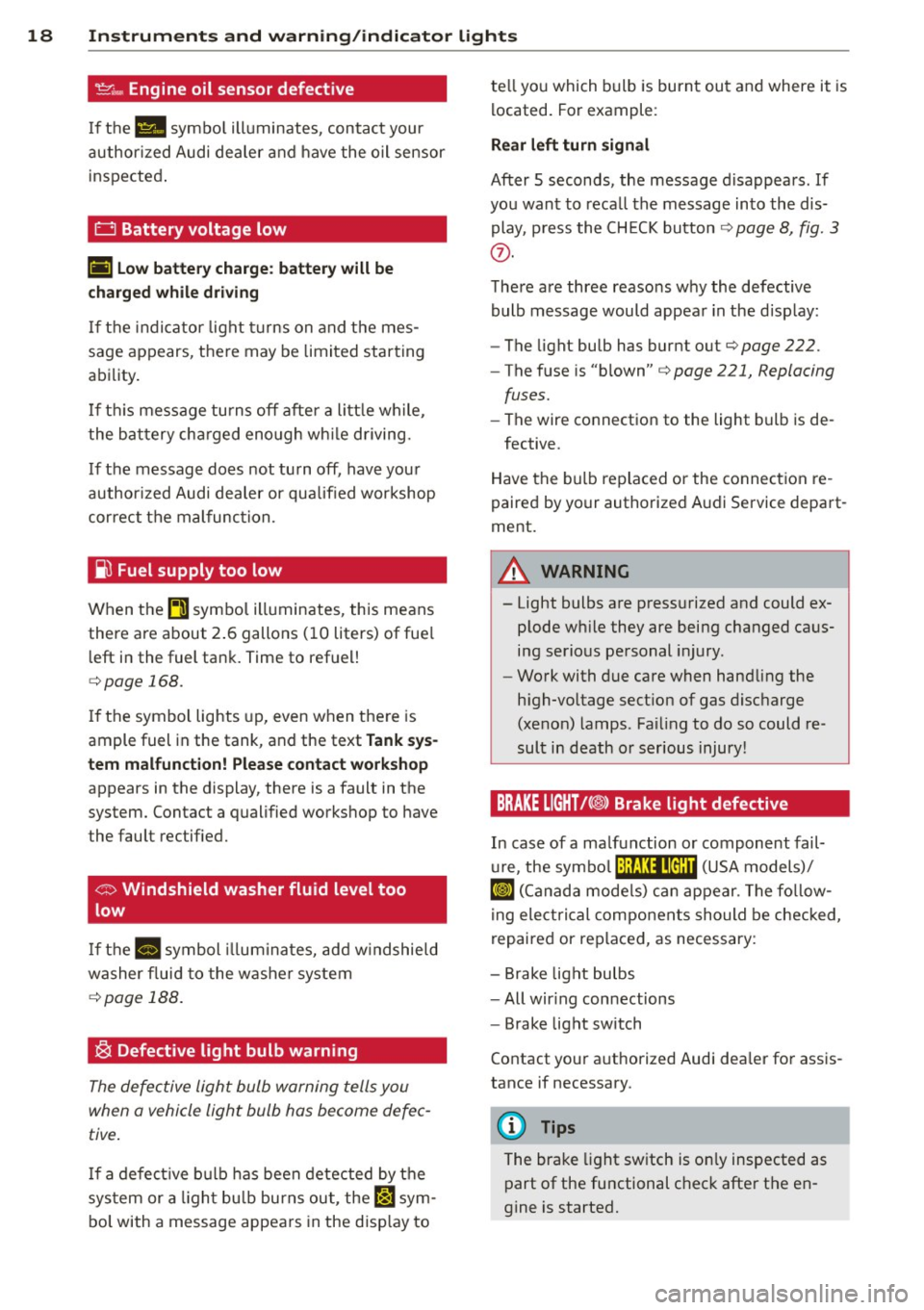
18 Instrum ent s and w arn ing /indic ato r light s
't':r.,. Engine oil sensor defective
If the Ill symbo l illuminates, contact your
author ized Audi dealer and have the oil sensor
inspected .
0 Battery voltage low
(•) Low batter y ch arg e: batt ery wi ll be
charged while dri ving
If the indicator light turns on and t he mes
sage appears, there may be limited starting
ability.
I f th is message turns off after a litt le wh ile,
the battery cha rged enough wh ile driving.
If the message does not turn off, have your
author ized Audi dealer or qualified workshop
correct the malfunction.
~ Fuel supply too low
When the~ symbo l illuminates, this means
there are about 2 .6 gallons (10 liters) of fue l
l eft in the fuel tank. Time to refuel!
c::> page 168.
If the symbol lights up, even when the re is
ample fuel in the tank, and the text
Tank sys
tem m alfunct ion! Plea se cont act workshop
appears in the display, there is a fault in the
system. Contact a qualified workshop to have
the fault rectified.
<;:> Windshield washer fluid level too
low
If the -· "ymbol illum inates, add w indshield
washer f luid to the washer system
c::> page 188.
~ Defective light bulb warning
The defective light bulb warning tells you
when a vehicle light bulb has become defec tive .
If a defect ive b ulb has been detected by the
sys tem or a ligh t bu lb burns out , the
l',sl sym
bol with a message appears in the disp lay to te
ll yo u which bulb is burnt out and where it is
located. For example:
Rear left turn sign al
After 5 seconds, the message disappears . If
you want to reca ll the message into the dis
play, p ress the CH ECK button
c::> page 8, fig. 3
(J).
The re are three reasons why the defective
bulb message would appear in the disp lay:
- The light bulb has burnt out
c::>page 222.
-The fuse is "blown" c::> page 221, Replacing
fuses.
- The wire connection to the light bulb is de-
fective.
Have the bulb replaced or the connection re
paired by your authorized Audi Service depart
ment.
A WARNING
-- Light bulbs are pressurized and could ex- plode wh ile they are being changed caus
ing serious personal injury.
- Work with due care when handling the
high-vo ltage sect ion of gas discharge
(xenon) lamps. Fa iling to do so could re
sult in death or serious injury!
BRAKE LIGHT t<@> Brake light defective
In case of a ma lfunction or component fail-
u re, the symbo l (USA models)/
¢@ )
repaired or rep laced, as necessary:
- Brake light bulbs
- All wir ing connections
- Brake light switch
Contact your a uthorized Audi dea ler for assis
tance if necessary.
(D Tips
The brake light sw itch is on ly inspected as
part of the functional check after the en
gine is started.
Page 149 of 244
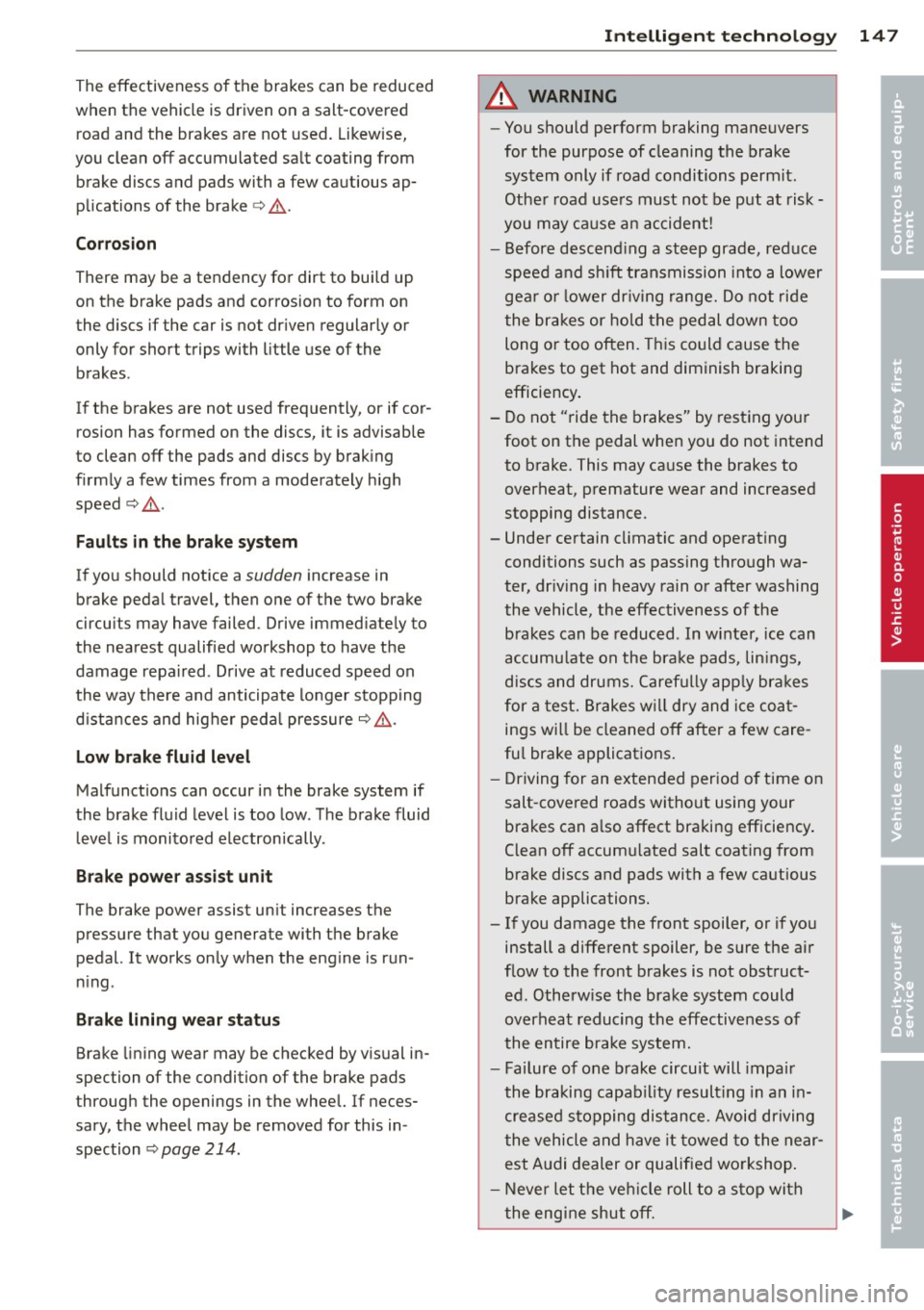
The effectiveness of the brakes can be reduced
when the vehicle is dr iven on a salt -covered
road and the brakes are not used. Likewise,
you clean
off accumulated salt coating from
brake discs and pads with a few ca utious ap
plications of the brake<=>,& .
Co rrosion
There may be a tendency for dirt to build up
on the brake pads and corrosion to form on
the discs if the car is not dr iven regularly or
only for short trips with little use of the
brakes.
If the brakes are not used frequently, or if cor rosion has formed on the discs, it is advisable
to clean
off the pads and discs by brak ing
firmly a few times from a moderately high
speed<=> ,&.
Fa ult s in th e bra ke s yste m
If you should notice a sudden increase in
brake pedal travel, then one of the two brake
circu its may have failed. Drive immed iately to
the nearest qualified workshop to have the
damage repa ired. Drive at reduced speed on
the way there and anticipate longer stopping
d istances and higher peda l pressure¢ _&.
Low brake fluid level
Malfunctions can occur in the brake system if
the brake flu id level is too low . The brake fluid
l eve l is monito red electronically .
Brake po wer ass ist un it
The brake power assist un it increases the
pressure that you generate with the brake
pedal. It works only when the eng ine is run
ning.
Br ake lining w ear statu s
Brake lining wear may be checked by visual in
spection of the condition of the brake pads
through the openings in the wheel. If neces
sary, the wheel may be removed for this in
spection
¢ page 214 .
Int ellig ent technolog y 147
_& WARNING
-You should perform braking maneuvers
for the purpose of cleaning the brake
system only if road conditions permit.
Other road use rs must not be put at risk -
you may ca use an accident!
- Before descend ing a steep grade, reduce
speed and sh ift transmission into a lower
gear o r lower dr iving range. Do not ride
the brakes or hold the pedal down too
long o r too often. Th is could cause the
brakes to get hot and diminish braking
efficiency .
- Do not " ride the brakes" by resting you r
foot on the pedal when you do not intend to brake. This may cause the brakes to
overheat, premature wear and increased
stopping distance.
- Under certain cl imatic and operat ing
conditions such as passing through wa
ter, dr iv ing in heavy rain o r after washing
the vehicle, the effectiveness of the brakes can be reduced. In winte r, ice can
accumu late on the bra ke pads, lin ings,
discs and drum s. Carefully app ly bra ke s
for a test. Brakes w ill dry and ice coa t
ings w ill be cleaned
off after a few care
fu l brake applications.
- Driving for an extended period of time on
salt -cove red roads without using your
brakes can a lso affect braking efficiency .
Clean
off accum ulated salt coating from
brake discs and pads with a few cautious
brake applications.
- I f you damage the front spoiler, or if you
install a different spoiler, be sure the air
f low to the front brakes is not obstruct
ed. Otherw ise the brake system could
overheat reducing the effectiveness of
the entire brake system.
- Failure of one b rake circuit will impai r
the braking capab ility result ing in an in
creased stopping distance. Avoid driving
the vehicle a nd have it towed to the near
est A udi dealer or qualified workshop .
- Never let the veh icle roll to a s top with
the engine shut
off. .,.
•
•
Page 158 of 244
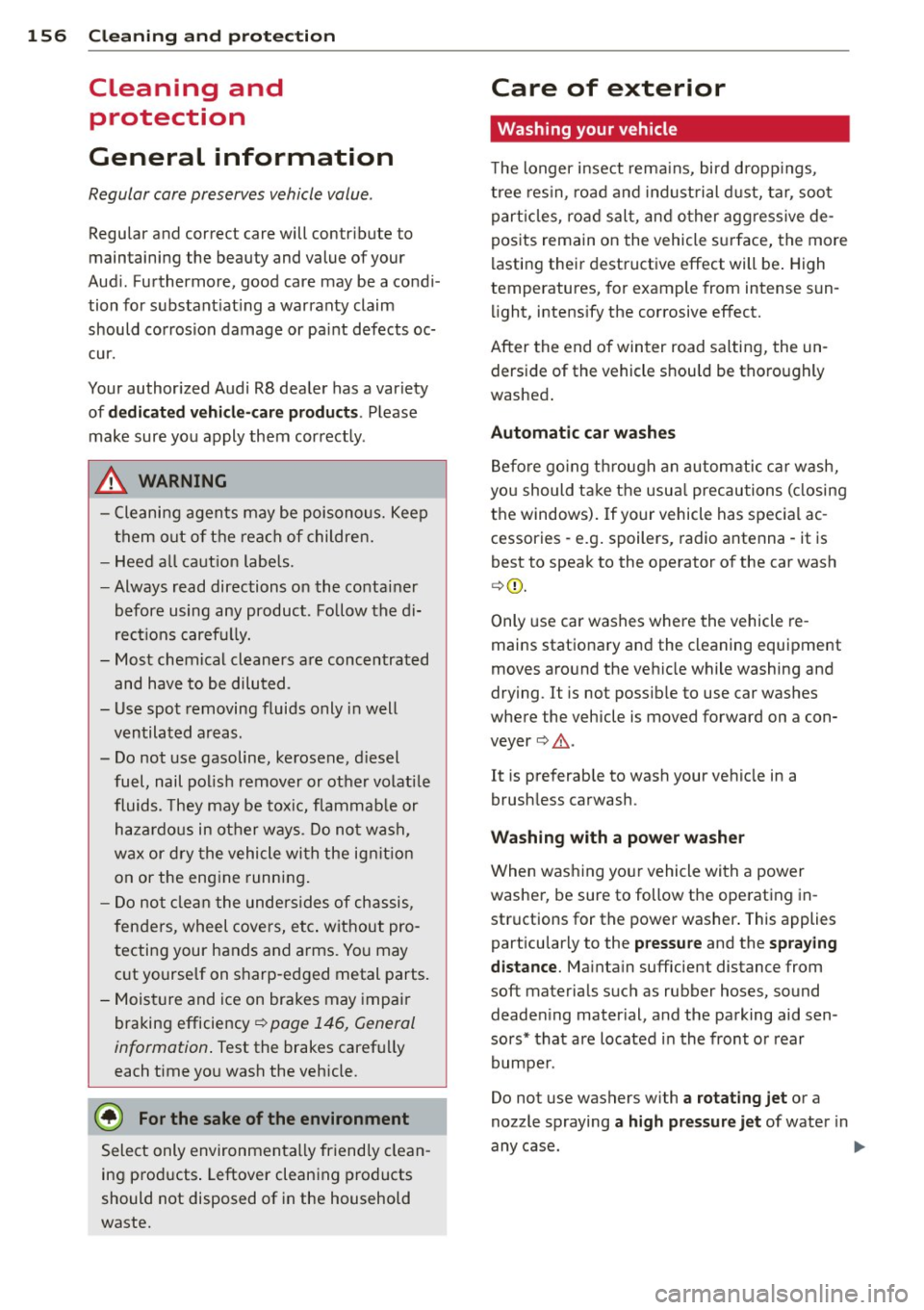
156 Cleaning and protection
Cleaning and protect ion
General information
Regular core preserves vehicle value .
Regular and correct care will contribute to
maintaining the beauty and value of your
Audi. Furthermore, good care may be a condi
tion for substant iat ing a warranty claim
should corrosion damage or pa int defects oc
cur.
Your authorized Audi R8 dealer has a variety
of
dedicated vehicle-care products. Please
make sure you apply them correctly .
.8, WARNING
-Cleaning agents may be poisonous. Keep
them out of the reach of children.
- Heed all caution labels.
- Always read directions on the container
before using any product . Follow the di
rect ions carefu lly.
- Most chemical cleaners are concentrated
and have to be diluted.
- Use spot removing fluids only in well
ventilated areas.
- Do not use gasoline, kerosene, d iesel
fuel, nail pol ish remover or other volatile
fluids. They may be toxic, flammable or
haza rdous in other ways. Do not wash,
wax or dry the vehicle with the ignit ion
on or the engine running.
- Do not clean the undersides of chassis,
fenders, wheel covers, etc. without pro
tecting your hands and arms. You may cut yourse lf on sharp-edged metal parts.
- Moisture and ice on brakes may impair
braking efficiency¢
page 146, General
information .
Test the brakes carefully
each time you wash the vehicle.
@ For the sake of the environment
Select only environmentally friend ly clean
ing products . Leftover cleaning products
should not disposed of in the household
waste.
Care of exterior
Washing your vehicle
T he longer i nsect remains, bird dropp ings,
tree res in , road and indust rial dust, tar, soot
part icles, road salt, and other aggressive de
posits remain on the vehicle surface, the more
lasting their destructive effect will be . High
temperatures, for example from intense sun
li ght, intens ify the corrosive effect.
After the end of winter road salting, the un
derside of the vehicle should be thoroughly
washed .
Automatic car washes
Before going through an automatic car wash,
yo u should take the usual precautions (closing
the windows). If your vehicle has special ac cessories -e.g . spoilers, radio antenna -it is
best to speak to the operator of the car wash
c:> (D .
Only use car washes where the vehicle re
mains stationary and the cleaning equipment
moves aro und the vehicle while washing and
drying . It is not possib le to use car washes
where the vehicle is moved forward on a con
veyer
c:> ,& .
It is preferab le to wash your vehicle in a
brush less carwash .
Washing with a power washer
When washing yo ur vehicle with a power
washer, be sure to follow the operating in
structions for the power washer . This applies
particularly to the
pressure and the spraying
distance.
Maintain sufficient distance from
soft materials such as rubber hoses, sound
deaden ing mater ial, and the parking aid sen
sors* that are located in the front or rear
bumper .
Do not use washers with
a rotating jet or a
nozzle spraying
a high pressure jet of water in
any case. ..,.
Page 175 of 244
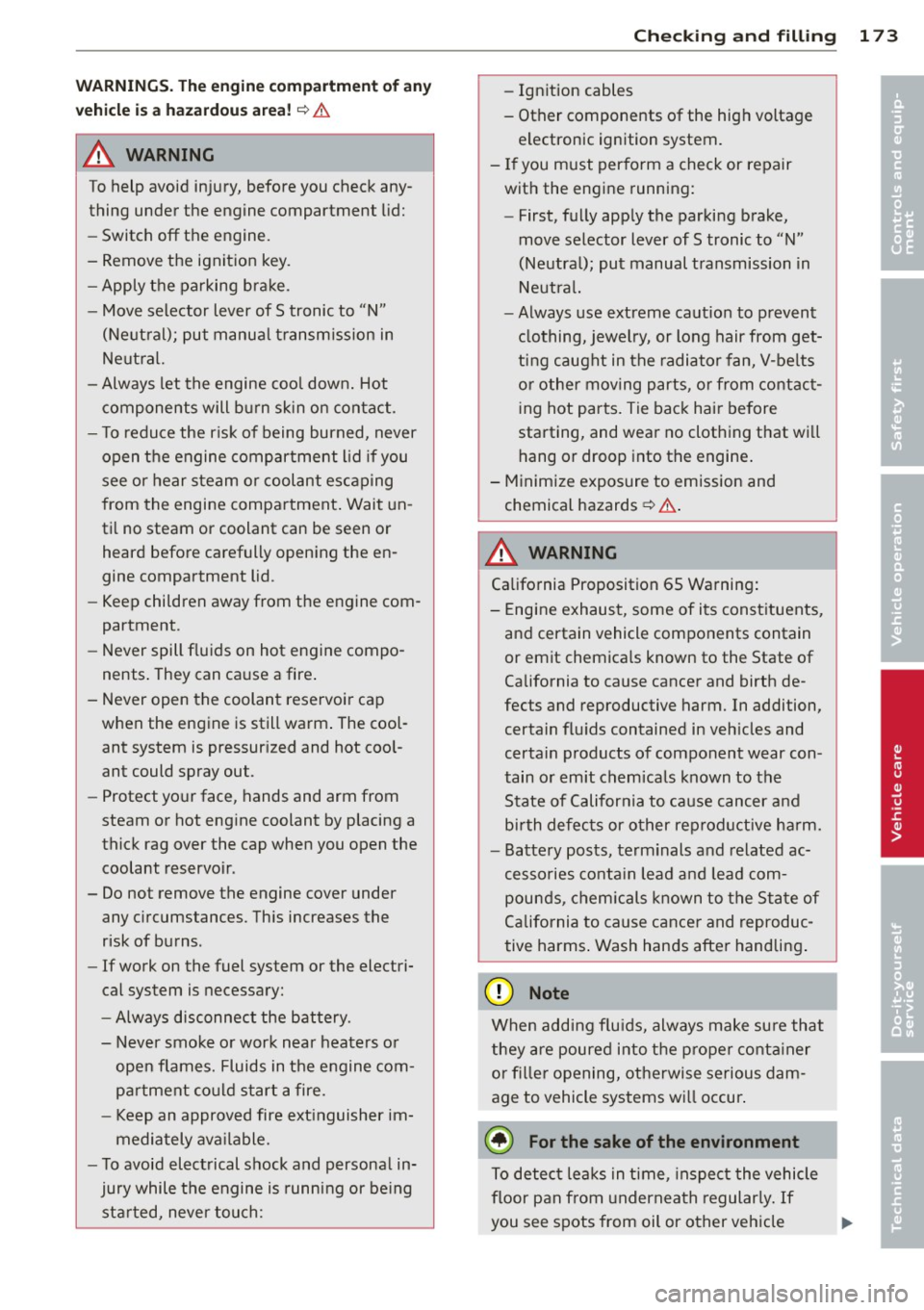
WARNINGS. The engine compartment of any
vehicle is a hazardous area!
c::> &.
A WARNING
To help avoid injury, before you check any
thing under the engine compartment lid:
- Switch off the engine.
- Remove the ignition key.
- Apply the parking brake.
- Move selector lever of S tronic to "N"
(Neutral); put manual transmission in
Neutral.
- Always let the engine cool down. Hot
components will burn skin on contact.
- To reduce the risk of being burned, never
open the engine compartment lid if you
see or hear steam or coolant escaping
from the engine compartment. Wait un
til no steam or coolant can be seen or heard before carefully opening the en
gine compartment lid .
- Keep children away from the engine com
partment .
-Never spill fluids on hot engine compo
nents. They can cause a fire.
- Never open the coolant reservoir cap when the engine is still warm. The coolant system is pressurized and hot cool
ant could spray out.
- Protect your face, hands and arm from
steam or hot engine coolant by placing a
thick rag over the cap when you open the
coolant reservoir .
- Do not remove the engine cover under
any circumstances. This increases the
risk of burns.
- If work on the fuel system or the electri
cal system is necessary:
- Always disconnect the battery.
- Never smoke or work near heaters or
open flames. Fluids in the engine com
partment could start a fire.
- Keep an approved fire extinguisher im
mediately available.
- To avoid electrical shock and personal in
jury while the engine is running or being
started, never touch:
Checking and filling 173
- Ignition cables
- Other components of the high voltage electronic ignition system.
- If you must perform a check or repair
with the engine running:
- First, fully apply the parking brake,
move selector lever of S tronic to "N"
(Neutral); put manual transmission in
Neutral.
- Always use extreme caution to prevent
clothing, jewelry, or long hair from get
ting caught in the radiator fan, V-belts
or other moving parts, or from contact ing hot parts. Tie back hair before
starting, and wear no clothing that will hang or droop into the engine.
- Minimize exposure to emission and chemical hazards
c::> .&. .
A WARNING
California Proposition 65 Warning:
- Engine exhaust, some of its constituents,
and certain vehicle components contain
or emit chemicals known to the State of
California to cause cancer and birth de
fects and reproductive harm. In addition, certain fluids contained in vehicles and
certain products of component wear con
tain or emit chemicals known to the
State of California to cause cancer and birth defects or other reproductive harm.
- Battery posts, terminals and related ac
cessories contain lead and lead com
pounds, chemicals known to the State of
California to cause cancer and reproduc
tive harms. Wash hands after handling.
@ Note
When adding fluids, always make sure that
they are poured into the proper container
or filler opening, otherwise serious dam
age to vehicle systems will occur.
@ For the sake of the environment
To detect leaks in time, inspect the vehicle
floor pan from underneath regularly. If
you see spots from oil or other vehicle
IJI>
•
•
Page 185 of 244
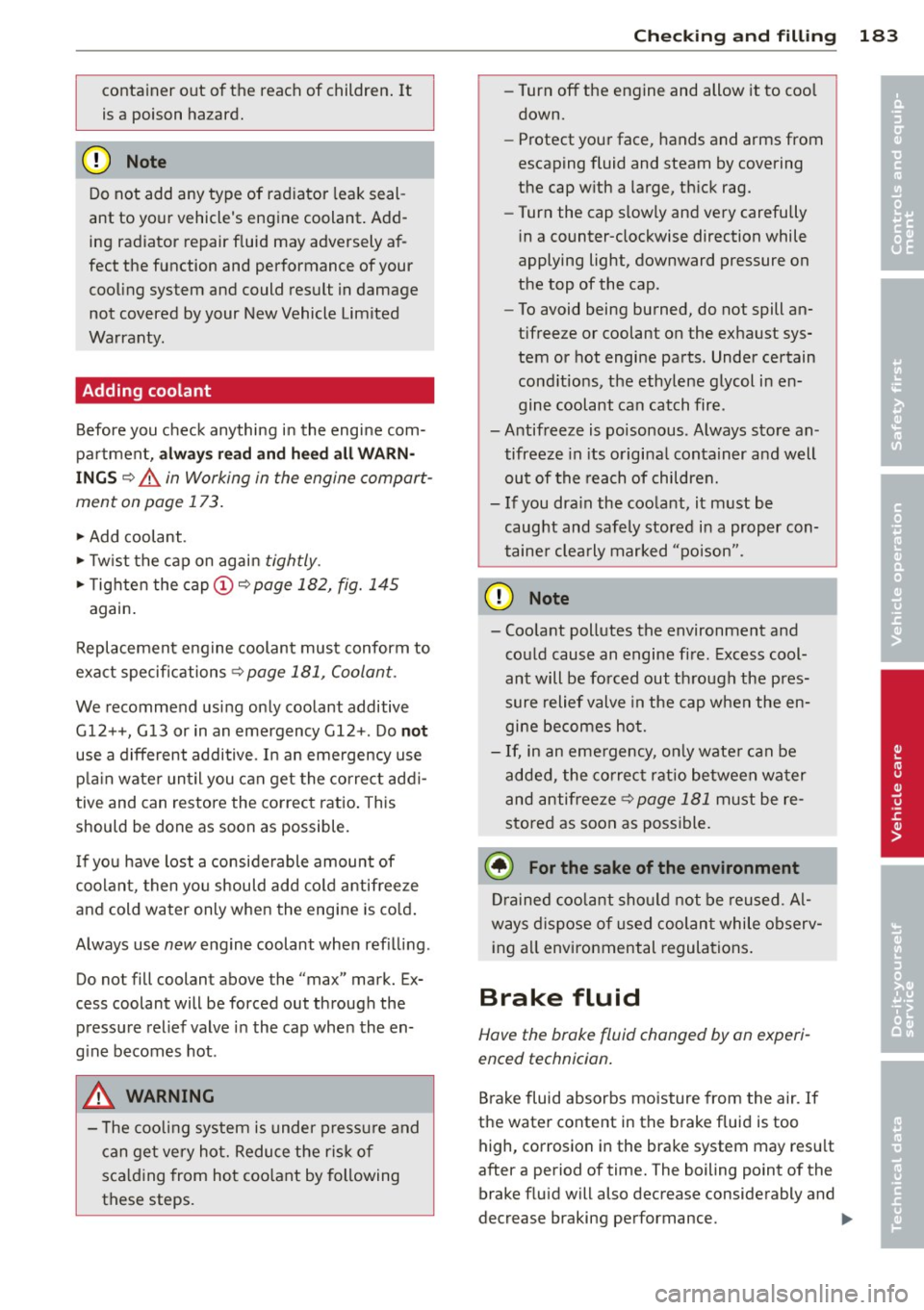
container out of the reach of children. It
is a poison hazard.
@ Note
Do not add any type of radiator leak seal
ant to your vehicle's engine coolant. Add
ing radiator repair fluid may adversely af
fect the function and performance of your
cooling system and could result in damage
not covered by your New Vehicle Lim ited
Warranty.
Adding coolant
Before you check anything in the engine com
partment,
always read and heed all WARN
INGS q A in Working in the engine compart
ment on pag e 173.
"'Add coolant .
"'Twist the cap on again
tightly.
"'Tighten the cap (D q page 182, fig. 145
again.
Replacement engine coolant must conform to
exact specifications
q page 181, Coolant .
We recommend using only coolant additive
G12++, G13 or in an emergency G12 +. Do
not
use a different additive. In an emergency use
plain water until you can get the correct addi
tive and can restore the correct ratio. This
should be done as soon as possible.
If you have lost a considerable amount of
coolant, then you should add cold antifreeze
and cold water only when the engine is cold.
Always use
new engine coolant when refilling .
Do not fill coolant above the "max" mark. Ex
cess coolant will be forced out through the
pressure relief valve in the cap when the en
gine becomes hot.
A WARNING
- The cooling system is under pressure and
can get very hot. Reduce the risk of
scalding from hot coolant by following
these steps.
Checking and filling 183
- Turn off the engine and allow it to cool
down.
- Protect your face, hands and arms from
escaping fluid and steam by covering
the cap with a large, thick rag.
- Turn the cap slowly and very carefully
in a counter-clockwise direction while
applying light, downward pressure on
the top of the cap.
- To avoid being burned, do not spill an
tifreeze or coolant on the exhaust sys
tem or hot engine parts. Under certain
conditions, the ethylene glycol in en
gine coolant can catch fire .
- Antifreeze is poisonous. Always store an
tifreeze in its original container and well
out of the reach of children.
- If you drain the coolant, it must be
caught and safely stored in a proper con
tainer clearly marked "poison" .
Q) Note
- Coolant pollutes the environment and
could cause an engine fire . Ex cess cool
ant will be forced out through the pres
sure relief valve in the cap when the en
gine becomes hot.
- If, in an emergency, only water can be
added, the correct ratio between water
and antifreeze
q page 181 must be re
stored as soon as possible.
@ For the sake of the environment
Drained coolant should not be reused . Al
ways dispose of used coolant while observ
ing all environmental regulations.
Brake fluid
Have the brake fluid changed by an experi
enced t echnician.
Brake fluid absorbs moisture from the air. If
the water content in the brake fluid is too
high, corrosion in the brake system may result
afte r a period of time. The boiling point of the
brake fluid will also decrease considerably and
decrease braking performance. .,.. •
•
Page 186 of 244
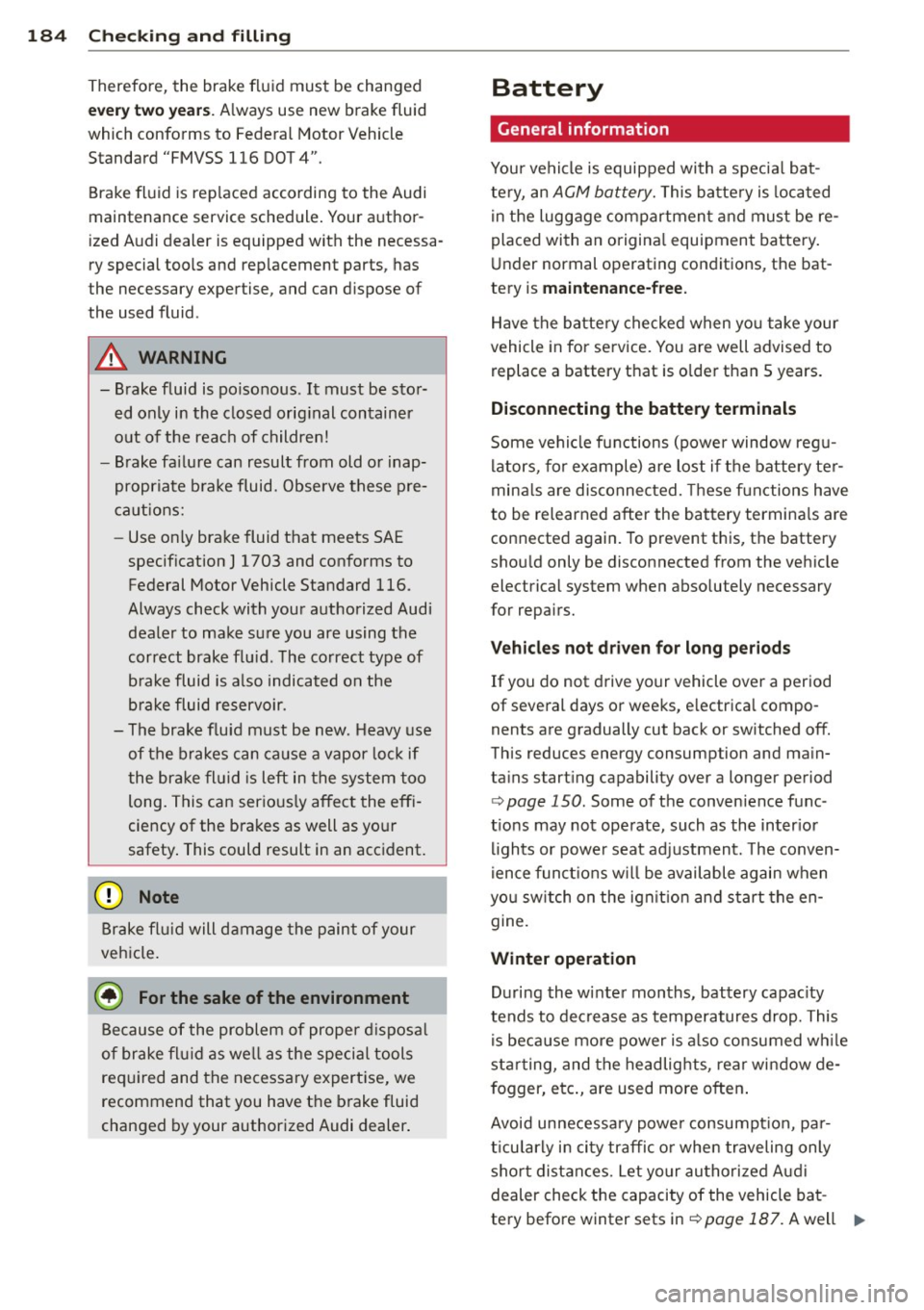
184 Checking and filling
Therefore, the brake fluid must be changed
ev ery two yea rs. A lways use new brake fluid
which conforms to Federal Motor Vehicle Standard "FMVSS 116 DOT 4".
Brake fl uid is rep laced according to the Audi
maintenance service schedule . Your author
ized Audi dealer is equipped with the necessa
ry special tools and rep lacement parts, has
the necessary expertise, and can d ispose of
the used fluid .
A WARNING
-Brake fluid is po isonous . It must be stor
ed only in the closed orig inal container
out of the reac h of children!
- Brake fa ilure can result from old o r inap
propriate b rake fluid. Observe these pre
c aut ions:
- Use on ly brake fluid that meets SAE
specif icat ion
J 1703 and conforms to
Federal Motor Vehicle Standard 116 .
Always check with your authorized Audi
dealer to make su re you are using the
correct brake flu id. The correct type of
b rake fluid is a lso indicated on the
b rake fluid reservoir.
- The brake fluid must be new. Heavy use
of the brakes can cause a vapor loc k if
t he brake fl uid is left in the system too
long. This can ser ious ly affect the effi
ciency of the brakes as well as yo ur
safety . This could result in an accident.
CJ) Note
Br ake fl uid will damage the paint of your
veh icle.
@.l For the sake of the environment
Because of the problem of prope r d isposa l
of brake fl uid as we ll as the speci al tools
req uired and the necessary expert ise, we
recommend that you have the brake fluid
changed by your authorized Audi dealer .
Battery
General information
Your vehicle is equipped with a specia l bat
te ry, an
ACM battery. This ba tte ry is located
i n the luggage compartmen t an d must be re
placed with an origina l equipment battery .
U nder normal operating conditions, the bat
tery is
maintenance -free.
Have the batte ry checked when yo u take your
vehicle in for service. You are well advised to
replace a battery that is o lde r than 5 years.
Disconnecting the battery te rminals
Some vehicle fu nctions (power window reg u
lators, for ex ample) are lost if the batte ry te r
mina ls are disconnected. These f unctions have
to be relearned after the battery termina ls are
connected again. To prevent this, the battery
sho uld only be disconnected from the veh icle
electrical system when abso lutely necessary
for repairs.
Vehicles not driven for long periods
If you do not drive your vehicle over a period
of seve ral days or weeks , e lectrica l compo
nents are gradually cut back or switched off.
This reduces energy consumption and ma in
ta ins start ing capability over a longer period
r:> page 150. Some of the convenience func
t ions may not operate, such as the inter ior
li ghts or powe r seat ad justment. The conven
ience funct io ns w ill be available again when
you sw itch on the ign it io n and s tart the en
gine.
Winter operation
D uring the winte r months, battery capac ity
tends to dec rease as temperatures drop. This
is because mo re power is a lso co nsumed wh ile
sta rting, and the headlig hts, rear win dow de
f ogger, e tc., are used more often .
Avoid unnecessa ry powe r consumpt ion, pa r
t icu lar ly i n city traffic o r when traveling only
sho rt dist ances. Let yo ur au thori zed Au di
dealer check the capacity of the vehicle bat -
tery before winter sets in
r:> page 187. A well ll>
Page 191 of 244
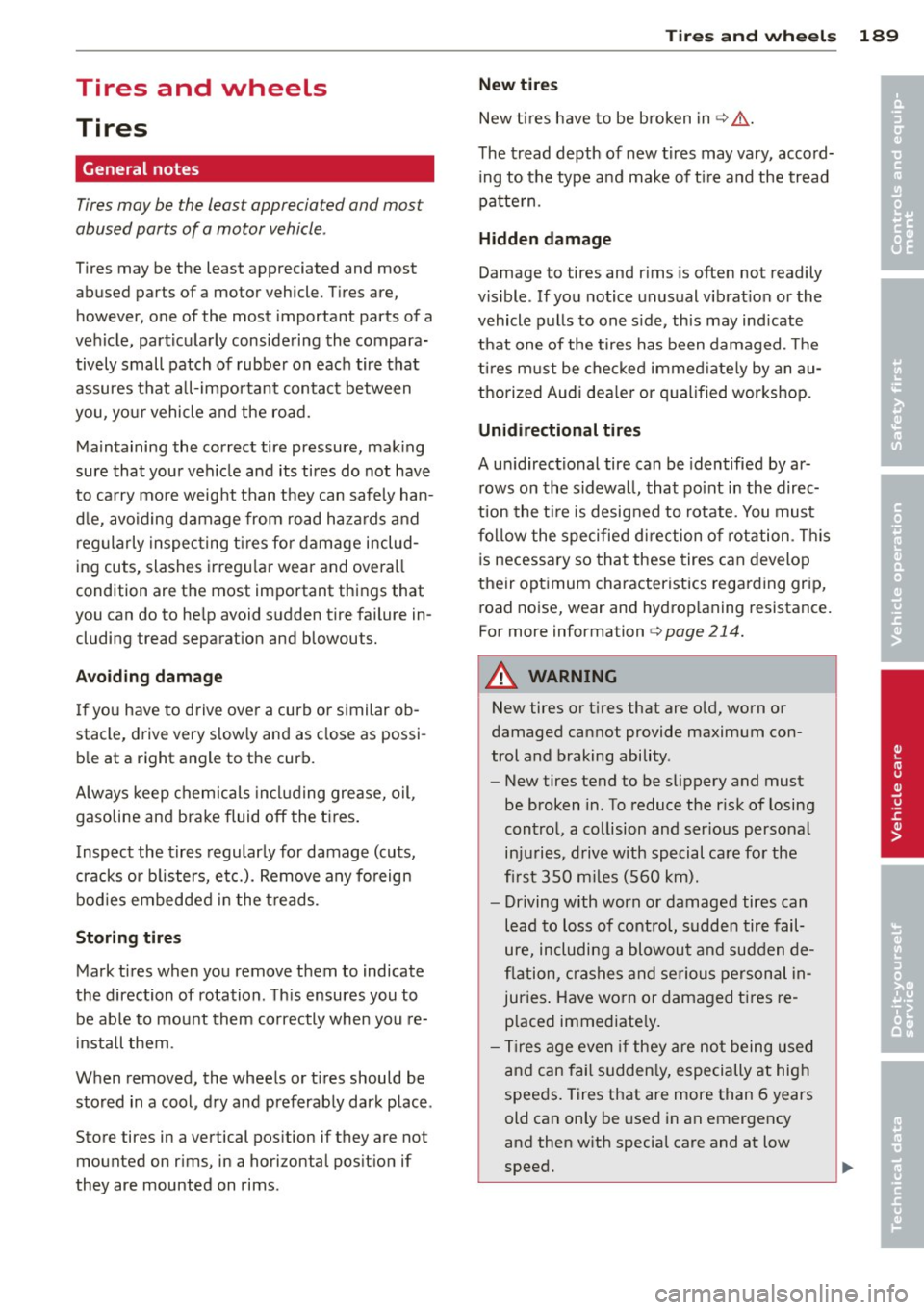
Tires and wheels
Tires
General notes
Tires may be the least appreciated and most
abused parts of a motor vehicle .
Tires may be the least appreciated and most
abused parts of a motor vehicle . Tires are,
however, one of the most important parts of a
vehicle, particularly considering the compara
tively small patch of rubber on each tire that
assures that a ll- important contact between
you, your vehicle and the road.
Maintaining the correct tire pressure, mak ing
sure that your vehicle and its tires do not have
to carry mo re weight than they can safely han
d le, avoiding damage from road hazards and
r eg ularly inspect ing t ires for damage i nclud
ing cuts, slashes irregu la r wear and ove rall
condition are the most important things that
you can do to he lp avoid sudden tire failure in
cluding tread separat ion and blowouts.
A voidin g damage
If you have to d rive over a curb or similar ob
stacle, drive very slow ly and as close as possi
b le at a right angle to the curb.
A lways keep chemicals includ ing grease, o il ,
gasoline and brake fluid off the t ires .
I nspect the t ires regularly for damage (cuts,
cracks or b listers, etc.). Remove any fo reign
bod ies embedde d in the treads.
Storing tires Mark tires when you remove them to indicate
the direction of rotation . T his ensures you to
be ab le to mount them correctly when you re
i nstall them .
When removed, the wheels or t ires should be
sto red in a cool, d ry and preferably dark place .
Store tires in a vertical pos ition if they are not
mounted on rims, in a horizontal pos it ion if
they are mounted on rims .
Tires an d wheel s 189
New tires
New ti res have to be broken in¢& .
The tread depth of new t ires may vary, accord
ing to the type a nd make of t ire and the tread
patte rn.
H idden damage
Damage to tires and r ims is ofte n not readily
visible . If you notice unusual v ib rat ion or the
vehicle pulls to one s ide, th is may ind icate
that one of the t ires has been damaged . T he
ti res m ust be chec ked immed iate ly by an au
thorized Audi dea le r or q ua lified wor kshop .
Unidirectional tires
A un idirectional tire can be identified by ar
rows on the sidewa ll, that po int in the direc
tion the t ire is designed to rotate. You mus t
f ol low the specified di rection o f rotation . T his
is necessary so that these tires can develop
their optimum characteristics regarding grip, road noise, wear and hydrop laning resistance.
For more information
¢ page 214.
A WARNING
New tires or t ires that are o ld, worn or
damaged cannot provide maximum con
trol and braking ability .
-
-New tires tend to be slippery and must
be broken in. To reduce the r isk of losing
control, a co llision and ser ious personal
in ju ries, d rive with special ca re for the
fi rst 350 m iles ( 560 km).
- Driving with worn or damaged tires can
lead to loss of control, sudden tire fail
ure, including a blowout and sudden de
fl ation, cras hes and se riou s personal in
juries . Have worn or damaged t ires re
placed immediate ly.
- Ti res age even if they are not being used
and can fai l sudden ly, especially at hig h
speeds. Tires that are more than 6 years
old can only be used in an emergency
and then w ith special care and at low
speed.
•
•